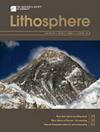中国龙华低结晶度玉髓:特征及成因
IF 1.7
4区 地球科学
Q3 GEOCHEMISTRY & GEOPHYSICS
引用次数: 0
摘要
在河北省龙化县晚侏罗世张家口组流纹岩火成岩中发现了一种低结晶度的玉髓。这种玉髓是沿寄主岩石脆弱裂缝的填充物,不同于其他的玉髓矿床,如已知的玄武岩和碳酸盐岩相关类型。寄主岩为流纹岩型火成岩,主要由辉石(50-70 vol.%)、斜长石(10-15 vol.%)、石英(8-10 vol.%)、镁质黑云母(3-5 vol.%)及附属矿物组成。玉髓呈长透镜状脉和不规则体,偶尔在边界处含有周围岩石的小碎片。颜色为黄色、红色和/或白色/无色,物理性能为比重2.55-2.56,反射指数1.54,莫氏硬度6.07-6.34,加热失重1.97%-2.32%。从晶界到内层中心,其生长结构由梳状大晶石英到细纤维晶再到相对均匀的隐晶相,表明其由晶向隐晶序析出。电子探针和拉曼光谱分析表明,玉髓组分矿物为α-石英和莫干石,红色包裹体为赤铁矿。玉髓中的石英呈血小板状,微孔由纳米颗粒胶结而成,其结构与蛋白石较为接近。x射线衍射图显示其结晶度指数(CIs)在~1 ~ 3之间。这种低CI和结构特征,连同它的出现,表明其形成时的低温为40°C - 80°C。所有这些性质都显示出与大多数报道的玉髓的区别。该玉髓为普通玉髓向蛋白石过渡的中间过渡类型,为认识微晶硅矿物集合体和寻找同类宝石矿床提供了新的思路。本文章由计算机程序翻译,如有差异,请以英文原文为准。
Low-Crystallinity Index Chalcedony from Longhua, China: Characteristics and Formation
A low-crystallinity index chalcedony was found in the rhyolitic ignimbrite of the Late Jurassic Zhangjiakou Formation, located in Longhua County, Hebei Province, China. This chalcedony occurs as fillings along the fragile fractures of the host rock and is distinct from any other chalcedony deposits, such as the known basalt and carbonate-related types. The host rock is rhyolitic ignimbrite, comprising sanidine (50–70 vol.%), plagioclase (10–15 vol.%), quartz (8–10 vol.%), magnesian biotite (3–5 vol.%), and accessory minerals. The chalcedony appears as long lenticular veins and irregular-shaped bodies, occasionally containing small fragments of the surrounding rock at the boundary. It is colored in yellow, red, and/or white/colorless, with physical properties of specific gravity 2.55–2.56, reflection index of 1.54, Mohs hardness of 6.07–6.34, and weight loss of 1.97%–2.32% by heating. From the boundary to the inner center, its growth structure changes from comb-like macrocrystalline quartz to thin fiber crystallites and then to a relatively uniform cryptocrystalline phase, indicating precipitation from a crystalline to the cryptocrystalline sequence. Electron probe and Raman spectroscopy analyses reveal that the component minerals of the chalcedony are α-quartz and moganite and that the red inclusions are hematite. Quartz in chalcedony exhibits platelet shapes with tiny pores, which are cemented by nanograins, and such a structure is closer to that of opal. It’s crystallinity indexes (CIs) range ~1–3, as indicated by the X-ray diffraction patterns. This low CI and structural features, together with its occurrence, suggest a low temperature of 40°C–80°C during its formation. All these properties show a distinction from those of the most reported chalcedonies. This chalcedony is interpreted as an intermediate transitional type from normal chalcedony to opal, shedding new light on understanding microcrystalline silica mineral aggregate and exploration for a similar gem deposit.
求助全文
通过发布文献求助,成功后即可免费获取论文全文。
去求助
来源期刊

Lithosphere
GEOCHEMISTRY & GEOPHYSICS-GEOLOGY
CiteScore
3.80
自引率
16.70%
发文量
284
审稿时长
>12 weeks
期刊介绍:
The open access journal will have an expanded scope covering research in all areas of earth, planetary, and environmental sciences, providing a unique publishing choice for authors in the geoscience community.
 求助内容:
求助内容: 应助结果提醒方式:
应助结果提醒方式:


